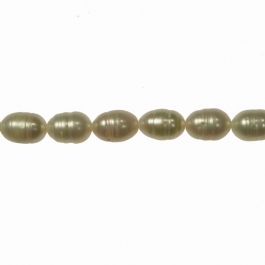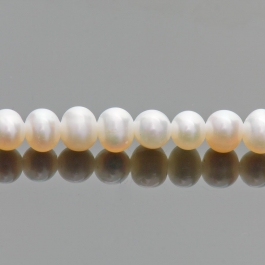- NEW DVD Series – Stone Setting with Bezels
- Tube Set Charm by Kim St. Jean
- Prong Basket Pendant by Kim St. Jean
- NEW DVD Series – Stone Setting with Cold Connections
- New DVD Series – Stone Setting with Wire
- NEW DVD Series: Introduction to Stone Setting by Kim St. Jean
- Featured Tool: Bracelet Bending Plier
- NEW Dvd by Eva Sherman
- Fun, Fast Fold Forming DVD Series
- Double Band Ear Cuff from Alex Simkin
Pearls: It’s a Cultural Thing!
by Rose Marion, Wire-Sculpture.com
Today I want to share a few interesting facts about pearls. You see, I’m very interested in Victorian and Edwardian times, and I was reading the other day that it was during this time period that the pearl was "cultured." Just imagine: all the pearls we take for granted today, worn on bridal headpieces, in corsages, and to a nice evening out: all of those would be completely unaffordable were it not for the work of Kokichi Mikimoto, commonly celebrated as the father of the cultured pearl, who produced cultured pearls starting in 1916, right around the start of the First World War. This is how late Edwardian jewelry came to feature so many pearls: it was the start of a new era for pearls, leading up to such a proliferation of pearls that the "50’s housewife" of course had a pearl necklace: the pearl was so common and affordable by that point. Just 50 years prior, pearls were painstakingly collected and matched to form just a single strand worth thousands.
Interestingly, the Japanese Tokichi Nishikawa and Tasuhei Mise both independently developed a method of creating pearls, before Kokichi Mikimoto; inserting a tiny slice of a mollusk into another mollusk’s body, causing a pearl to develop. However, the Nishikawa-Mise discovery was limited to producing mabe pearls, which are hemispherical, or half-round, being flat on the back, and were being used in earrings. Mikimoto knew of the Nishikawa-Mise discovery, but couldn’t use the same method if he was to create his own patent and method. So, he decided to use the method with a slight twist, creating round pearls. As a result, Kokichi Mikimoto was successful enough to buy the rights to the Mise-Niskikawa method and become known for developing the cultured pearl.
(As a matter of note, there is a claim that Nishikawa and Mise’s step-father witnessed pearl cultivation at Thursday Island, Australia. The operation was run by William Saville-Kent, a British expatriate living in Australia. Hence the coincidental, "simultaneous yet independent" discovery of Nishikawa and Mise when they returned to Japan – but, not all believe this version of history.)
Before cultivation, Chinese pearls came largely from freshwater rivers and ponds, and most Japanese pearls came from the saltwater coast. But Asia was not the only source for pearls. The New World had pearls, too. While the English and the French encountered Native Americans wearing pearls, and discovered freshwater pearls in the Mississippi, Ohio, and Tennessee River basins, Spain focused on the Caribbean, Central, and South America, forcing people to dive for pearls.
The United States became known for its freshwater pearls, prized in European collections, and Iowa became the center of an industry producing mother-of-pearl buttons, an era which lasted until WWII, when plastic reinvented the button market.
The United States is still incredibly involved in the pearl market, but not just in its native-grown pearls. Kokichi Mikimoto and other pearl culturing pioneers tested all kinds of materials to nucleate pearls from: gold, silver, glass, lead, and clay, but the best success came from round nuclei cut from US mussel shells. So US mussels have been the nucleus of nearly all cultured saltwater pearls for over 100 years!
Pearls have been used and treasured since at least 2200 BC, which was recorded in the Chinese historical text the Shu King, which recorded tributes sent by small kingdoms to the great king of China; some tributes contained pearls. Ancient Egyptian, Roman, Greek, Byzantine, and Middle Eastern kingdoms also prized the pearl, as well as India. Scotland also boasts pearl-producing mollusks, but they are protected by law.
Imitation pearls can be made from mother-of-pearl, coral, or conch shell. Others can be simple glass beads that are coated with a solution containing fish scales. Faux pearls will not have the same bright luster, weight, or smoothness as real pearls. And you may have seen Swarovski pearls: these are faux pearls built on a crystal core and coated with a unique Swarovski finish (which Swarovski declines to elaborate on).
As far as the technical details of creating a pearl, here’s what I discovered. Nearly any living shelled mollusk can produce pearls, but today two main types of mollusks bask in attention for producing the gemstone-quality iridescent nacreous pearls prized for jewelry. These 2 mollusks are freshwater mussels and saltwater pearl oysters.
Pearls form when an irritant enters a mussel or oyster, cannot get out, and so the mollusk coats it with nacre, which is also uses to coat its shell, so it’s not a bother anymore. (Imagine if every time you got an eyelash in your eye, you turned it into a pearl! I would be rich!) Cultured pearls form when pearl "farmers" cut a small slit into the mollusk and place tiny pieces of tissue into the slits.
I hope you enjoyed this look at pearl "culture!" Happy birthday to our June-born readers, and I hope you discovered something you didn’t know about your June birthstone, pearl!
Explore pearl beads for jewelry-making:
 |
 |
 |
| Freshwater Pearls: New Stock |
Large Hole Pearls | Various Pearl Strands |
Have a Wire Jewelry Idea or Resource you’d like to share?
Click Here to submit your idea. You could be featured on our Blog!
Click to Receive Daily Tips by Email
Sources & further reading
- The Shu King
- Swarovski Pearls
- Pearls: Debunking a Japanese Myth
- Pearl
- The History of Pearls
- The Culture of Freshwater Pearls



















Judy Copeland
June 27, 2012 at 6:15 am
Hello,
So enjoyed this piece on pearls as I too am learning about how to use them in a silver linked necklace.
I am now working on a piece that uses at least a 9 or 10 mm round pearls stright hole drilled and having trouble finding fresh water pearls fitting that discription with in a aforadable price range. Noticed you had 11 x 9 mm rice pearls and wondered if those might work. From the pattern I am going by the piece uses round pearls with a bead cap attached to a two inch silver links.
This is so wonderful to hear of the history of pearls and comes at a good time as I started using more pearls within the two years.
Have a suggestion on another topic that may be of interest the history of the big pink conk shell pearls. Hapened upon that site looking for pearls and found it to be very interesting. Actually picked my own big conk shell and shook it to see if there might be anything in there and it does rattle, so debating wether to break the shell or not. Bought it while Honeymooning in Hawaii.
Judy
Thank you for all your helpful information.
kirsten
June 27, 2012 at 7:27 am
oh shared! well done. pearls are so often under utilized because people ONLY think of them as “classic” or “so retro” but i have used them extensively in steampunk jewelry, in sort of crazy wire wrap.. they work with almost anything if you pick the RIGHT pearls for the right project.
and coin pearls and stick pearls (round and not round, lol) make great focal beads.
Rose
June 27, 2012 at 10:06 am
Thanks, Kirsten! Yes, there is a right pearl for nearly every project! Thanks for the kind words!
Kathy
June 28, 2012 at 1:52 am
This bit of “cultural” history was especially meaningful to me since I am one who celebrates a June birthday. I use pearls in quite a few of my designs, but the most precious piece that I treasure the most is a cultured pearl necklace that belonged to my grandmother. She passed away in 1992 at the age of 102 and I think she got the necklace sometime in the 1930s. I was the privileged granddaughter to receive this piece when she passed. Have never had it appraised but now it has even more meaning after reading this historical story about the pearl. Thanks for sharing this wonderful story. I would love to share parts of this on my blog with a link back to your blog if that is okay.
Rose
June 28, 2012 at 9:19 am
Certainly Kathy, thank you!
Kathy
July 5, 2012 at 6:34 pm
Hi again Rose-
Just wanted to let you know we included the information on cultured pearls in our blog. Wanted to provide the link so you could visit our blog; any comments are always welcome and please consider following us.
http://the3funkydivas.wordpress.com/2012/07/01/so-whats-in-a-pearl/
Thanks again for all the great tips and information you provide in your blog at Wire Sculpture!
Kathy
charlotte
June 28, 2012 at 5:25 pm
Well i have ALWAYS loved pearls,In the old days a girl often got a string of pearls on her 16th birthday from her family to show she was a young lady ,the one thing i did know is that Mikimoto Pearls are STILL the be all end of of Pearls,,my mom has wanted just ONE for YEARS and YEARS,,so this past christmas i managed to get her one,,lol,,if you could call it a pearl,,its dangling off a bookmark,,its tiny but it IS a MIKIMOTO peral,,wouldnt it be lovely if like in the old days we all got a string of pearls on out 16th birthday,,wish i were 16 again…
Bonnie DeHart
June 30, 2012 at 6:28 am
Love those pearls too. For those of you lucky ladies inheriting pearls, be aware that the body oils and perspiration can and will cause the silk thread to deterioraate. Wouldn’t hurt to have them restrung before they break. pearls are very soft too to keep in mind when using them in pieces where they might rub and wear, even on each other. That is why they are strung with knots in between each pearl. Working them into a piece with crystals is another consideration.
Pingback: So What’s in a Pearl? « The 3 Funky Divas
jake
July 2, 2012 at 3:50 am
Isn’t it our job as jewellery makers to see that every girl gets a strand on her 16th? As well as sculpting wire jewellery, i find it very therapeutic to knot a strand of pearls. Thanks to the advancements Rose so thoroughly mentions, they are really not that expensive, so you just have to devote the time (and the silk!) to knot them into a life-time piece. Then you can have the pride of passing it on at a graduation, wedding, or other life-defining time. Pearls truly are timeless, and when properly knotted into a strand, can be the landmark of a very special time in a girl’s life. i also find that a simple wire and pearl ring appeals to nearly everyone stepping into my booth
As well as sculpting wire jewellery, i find it very therapeutic to knot a strand of pearls. Thanks to the advancements Rose so thoroughly mentions, they are really not that expensive, so you just have to devote the time (and the silk!) to knot them into a life-time piece. Then you can have the pride of passing it on at a graduation, wedding, or other life-defining time. Pearls truly are timeless, and when properly knotted into a strand, can be the landmark of a very special time in a girl’s life. i also find that a simple wire and pearl ring appeals to nearly everyone stepping into my booth 